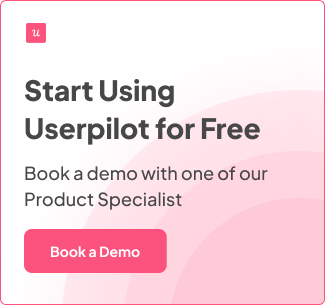UserGuiding vs Userlane: Which is Better for Interactive User Guides?
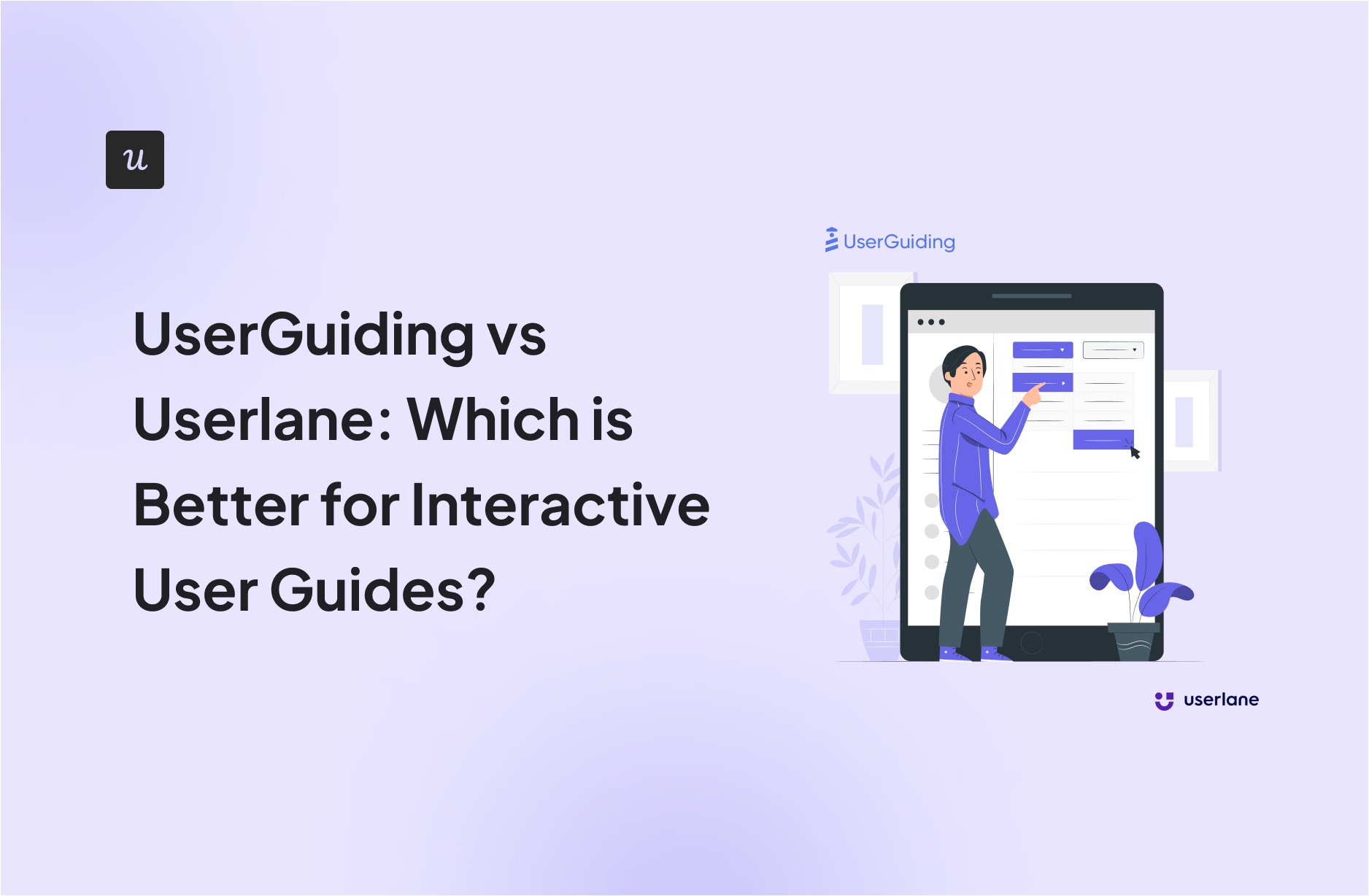
Is UserGuiding or Userlane the best tool for interactive user guides? Is there a better in-app onboarding software that would better fit your needs?
With so many alternatives on review sites, it’s a bit tricky to choose one.
You need to consider your priorities and what functionality you’ll need from the tool to get the job done. Then there’s also the price that needs to match your budget. Right?
In this post, we’ll discuss exactly that – what the perfect tool for creating interactive user guides should deliver and which will be the best choice for your company’s needs.
Let’s dive in!
TL;DR
- Let’s explore how UserGuiding and Userlane compare when it comes to creating interactive user guides.
- UserGuiding is a no-code product adoption tool that lets users create in-app walkthroughs, guides, and checklists. The solution makes it possible for teams to onboard, engage, and retain users without needing coding skills to create these in-app experiences.
- Userlane is a no-code digital adoption platform used to measure how employees use applications, identify areas for improvement, and offer real-time guidance directly within any application.
- If you’re looking for a better option for creating interactive user guides, Userpilot exceeds both functionality and value for money compared to other tools on the list.
- Userpilot is a product growth platform that drives user activation, feature adoption, and expansion revenue. It also helps product teams collect user feedback, streamline onboarding, and gather actionable insights from analytics. Get a Userpilot demo and drive your product growth code-free.
What is an interactive user guide?
An interactive user guide is a set of UI patterns designed to work together and help customers understand how to use your product.
There are two main types of user guides: full product tours (which tend to be more detailed and time-consuming), and interactive manuals (using tooltips and real-time guidance to provide more contextual help to your customers).
Interactive user manuals are an excellent way of engaging and educating your users, helping them to get the most out of your product, and improving user onboarding and feature adoption.
Must have features for interactive user guide tools
Not all tools are built the same. Some offer different advantages over others while some will simply get you basic functionality but at a low price. It depends on your budget and needs which will be the best tool to build interactive user guides.
Here’s what to look for as the main functionalities when picking a tool to build in-app guides:
- Good range of UI patterns to use for building your guides.
- Ability to customize each interactive guide to fit your brand and style.
- Segmentation so you could trigger the guides to the right audience at the right time. A one-size-fits-all approach won’t bring you the desired results.
- The ability to trigger the user guides when specific in-app events happen is nice to have and will help you build more contextual in-app experiences.
- Minimum product usage analytics, to be able to track how users engage with the product, and where they get stuck so you can build relevant user guides to help them.
The above list is not exhaustive but it’s a starting point. Depending on your product, you might also need automated localization, A/B testing capabilities, advanced analytics or security, and more.
UserGuiding for creating interactive user guides
UserGuiding lets you create interactive user guides by adding steps (either modals, tooltips, or input fields).
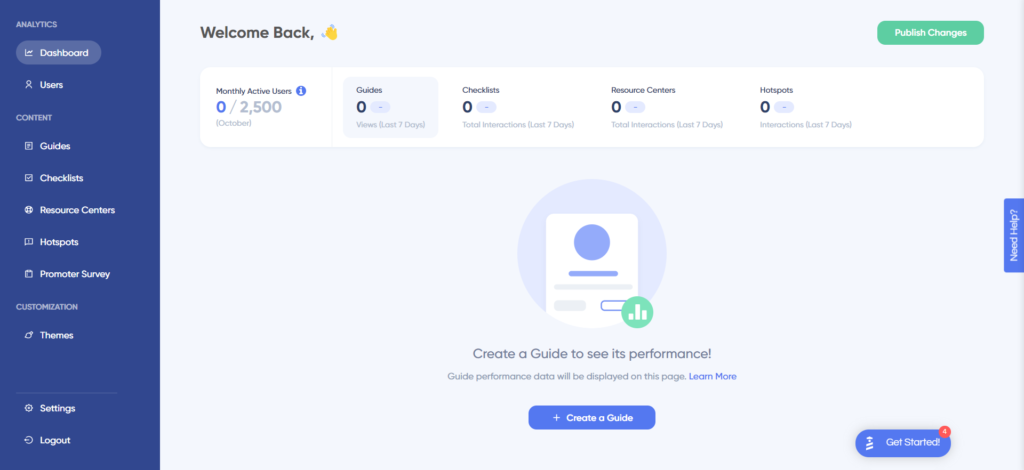
Here are the elements you can add:
- Modals: You can add modals to your interactive walkthroughs by starting from scratch or choosing one of the available modal templates in the walkthrough builder. There are templates for discounts, announcements, welcome screens, and hero modals.
- Tooltips: Much like the modals, tooltips can also be created from scratch or added using one of the templates. Templates include single-tip tooltips, visual tooltips, and tooltips that only show up when you click an element.
- Input Fields: Input fields aren’t as common in onboarding flows but could be used during the account creation process or during welcome surveys. When adding the step to your walkthrough, you can decide which input fields are mandatory versus optional for users to fill in.
- Copying: You can copy existing guides and then make minor changes to see if they perform better than the original. Unfortunately, you’ll need to interpret the resulting analytics manually, as UserGuiding has no native A/B testing capabilities.
- Triggers: Select between automatic or custom triggers, then decide whether an interactive user guide should only appear once versus whenever the targeting conditions are met.
No-code product tours in UserGuiding
UserGuiding does have the features necessary for creating basic product tours, but the no-code implementation will depend on how complex you need these onboarding flows to be. Full integration of the UserGuiding solution does require some updates to your coding.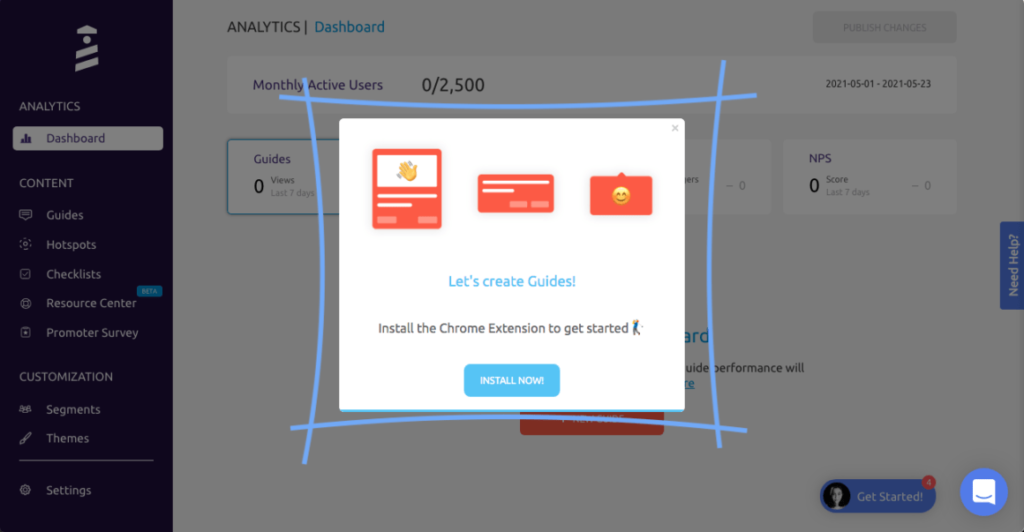
Here are a few UserGuiding features you can use in your product tours:
- Guides: The UserGuiding Chrome extension lets you add multi-step guides to any page of your website with elements like modals, tooltips, and input fields, then preview the flow before publishing.
- Checklists: Onboarding checklists give users a sense of progress as they move through your product tours (but UserGuiding only lets you have two active at a time unless you upgrade to the Professional plan or higher).
- Hotspots: A more subtle way to highlight specific features, buttons, or elements during product tours would be to use UserGuiding’s hotspot UI pattern.
In-app messaging in UserGuiding
An effective in-app messaging strategy can streamline onboarding, drive adoption, improve satisfaction, and generate expansion revenue. UserGuiding can help you localize in-app messages, target specific segments, and adjust frequency to avoid irritating users.
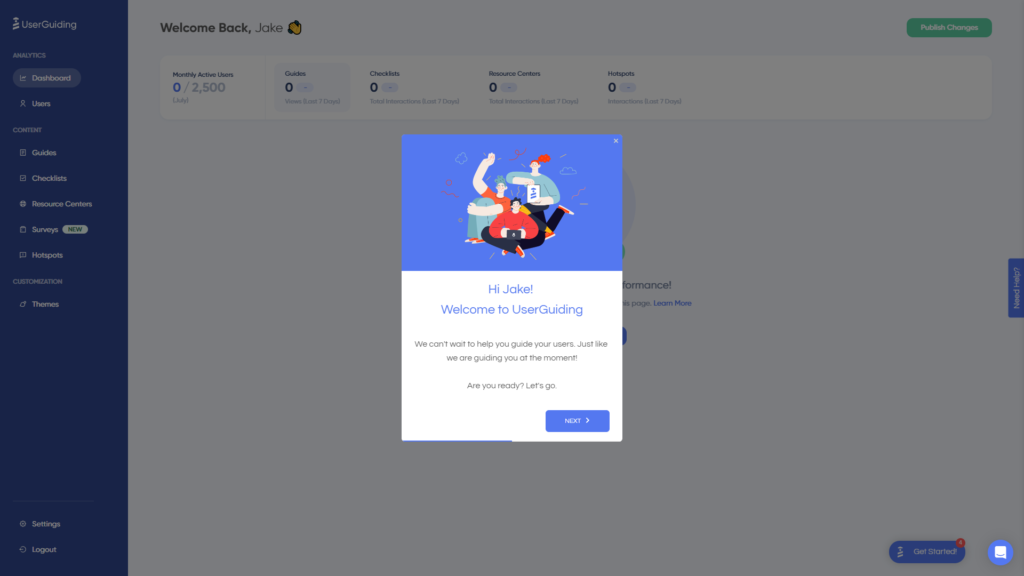
Here are the UserGuiding features that will be most useful for your in-app messaging efforts:
- Localization: UserGuiding lets you upload CSV files to localize in-app messages to the native language of your users. Unfortunately, there’s no AI-powered localization, so you’ll need to manually upload the CSVs for every language or dialect used in your in-app messaging.
- Segmentation: UserGuiding makes it possible to target specific segments with your in-app messaging to maximize relevancy and only show the most contextual messages. This avoids common issues like new users seeing upsells or power users seeing onboarding tips.
- Frequency: UserGuiding has appearance frequency customization settings that let you decide how often to show in-app messages when optimizing for engagement. This can help you moderate the pace of your in-app messaging so users don’t get burnt out or annoyed.
Userlane for creating interactive user guides
With the Userlane Editor, you can create powerful interactive guides within applications, enhancing user experiences and facilitating content creation and editing.
You can create guides within the application or tooltips to add explanations to an element within the application for your users. Let’s take a look at how Userlane can help you create interactive user guides:
- Real-time assistance: Userlane’s interactive guides are more than just pop-up hints. They provide context-aware help right when and where a user needs it. If a user seems stuck or unsure of the next step, Userlane’s guides can nudge them in the right direction, ensuring they’re not frustrated or overwhelmed.
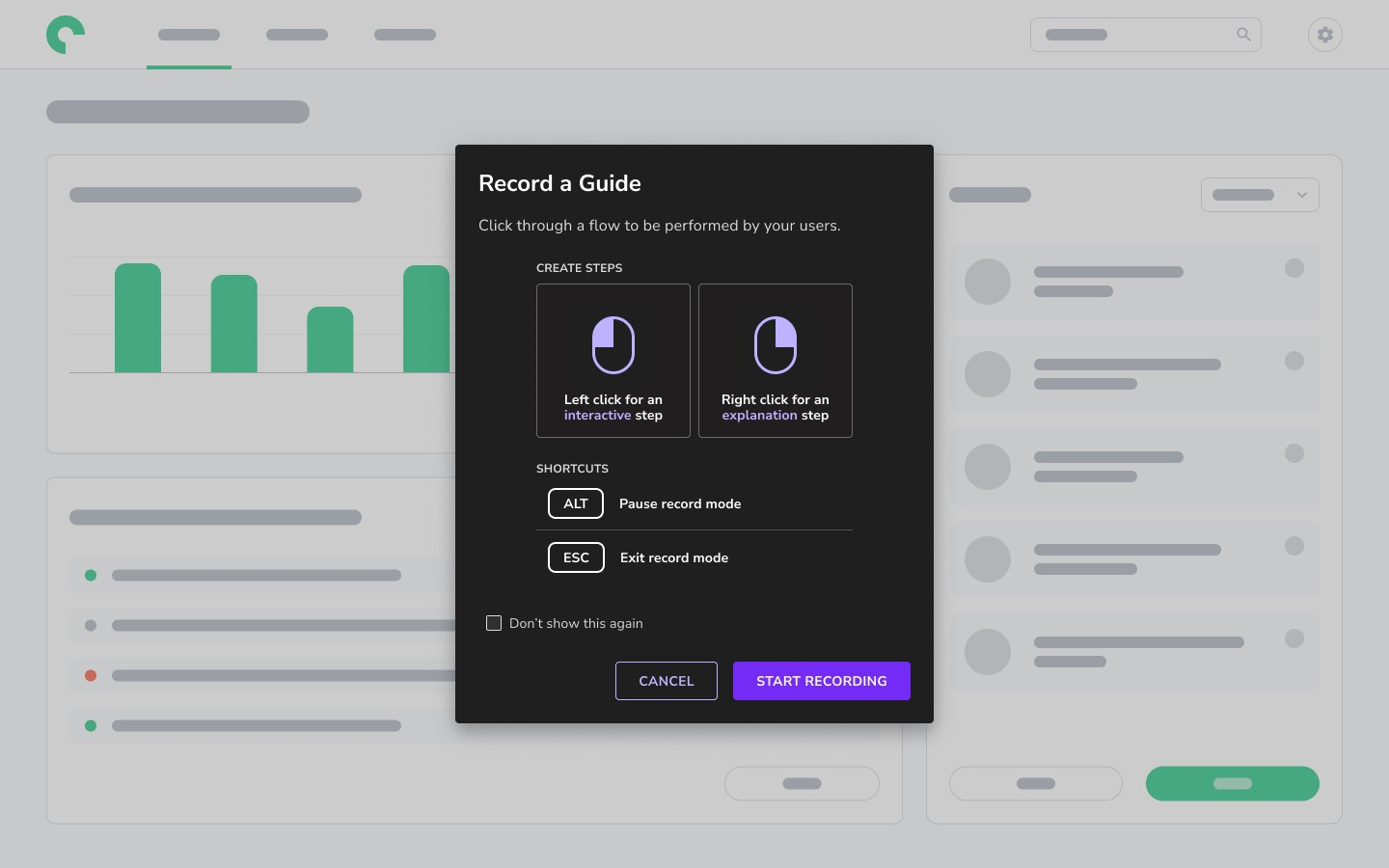
- Sleek learning path: Userlane allows the creation of adaptive learning paths. This means the guides can adjust in complexity and depth based on the user’s previous interactions, ensuring a customized and efficient learning experience. The platform’s no-code functionality allows these adaptive paths to be set up without needing to delve into complex coding or scripting.
- Seamless integration: Userlane understands that users have different learning preferences. Some prefer text, while others benefit from visuals or videos. The platform seamlessly integrates multimedia elements into the guides, ensuring a comprehensive and engaging learning experience.
No-code product tours in Userlane
Userlane is primarily designed to create interactive product walkthroughs with simplicity. For companies looking to integrate a basic onboarding experience without coding complexities, Userlane’s no-code platform is an ideal choice.
It provides a seamless solution for businesses to create in-app interactive content. Rather than requiring extensive coding and development effort, Userlane enables organizations to craft intuitive product tours rapidly.
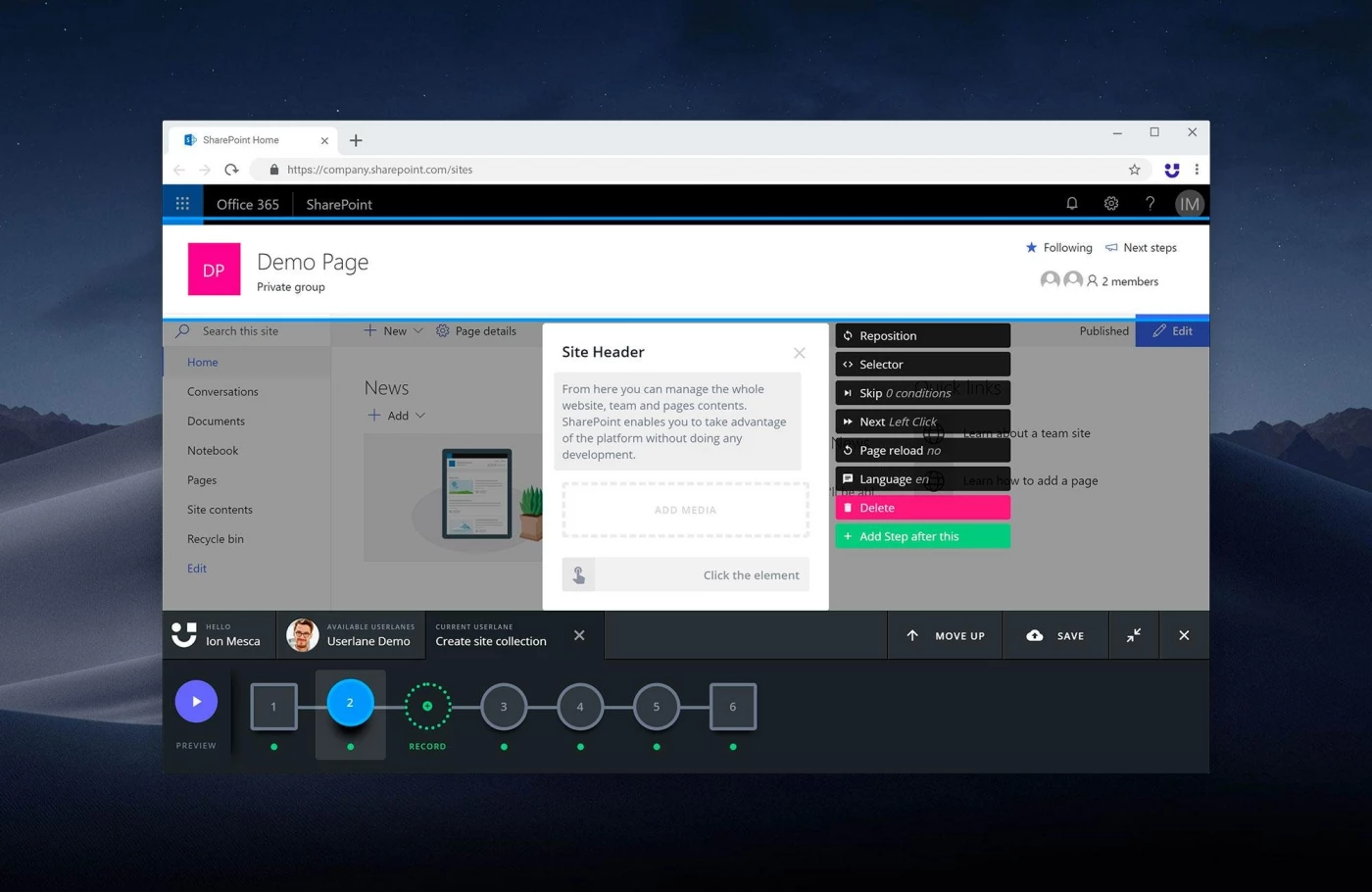
Here’s a breakdown of the features of Userlane for no-code product tours:
- Interactive Step-by-Step Guidance: Userlane offers a visual editor that allows creators to design step-by-step instructions directly within the application interface. These guides provide users with a hands-on approach to learning, leading them through real-time processes. This ensures that users aren’t just reading instructions but are actively engaged in performing tasks.
- Analytics and Performance Insights Without Code: Beyond just crafting the tours, Userlane’s no-code platform provides businesses with valuable insights into user engagement. Organizations can monitor the effectiveness of their onboarding content, pinpoint areas of improvement, and optimize their guides—all through a user-friendly, code-free dashboard.
- Personalized User Segmentation with No-Code Customization: Userlane’s no-code capabilities enable businesses to tailor tours based on user roles, preferences, or behaviors without diving into complex programming.
In-app messaging in Userlane
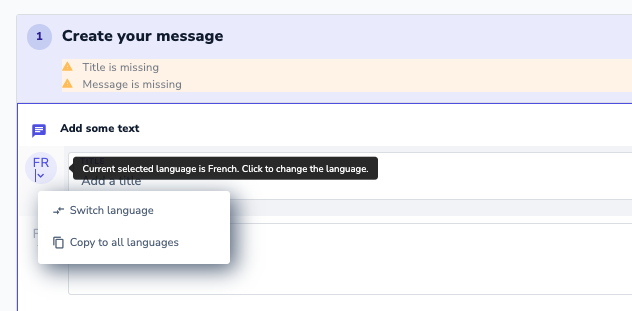
With Userlane, you can deliver in-app messages to your users through the Userlane Assistant. This way, you can communicate with your users without the hassle of using a Google translator to translate to their preferred language.
- Contextual Communication: Delivers tailored messages to users based on their actions, position within the app, or specific milestones, ensuring timely and relevant engagement.
- Role-Based Message Management: Grants specific permissions to administrators, moderators, and contributors in your product team, allowing for streamlined creation, editing, and publishing of in-app messages.
- Content-Rich Announcements: Supports the inclusion of various media types, like images, and offers capabilities to link messages directly to detailed guides, enhancing the depth and versatility of the messaging experience.
Pros and cons of UserGuiding
You might need an alternative solution to UserGuiding if you fall into any of the following use cases:
- Advanced analytics: If you’re looking for a product adoption platform with full-suite native analytics then you’ll likely need to look at platforms like Userpilot or Appcues that are better suited to your needs.
- Create fully interactive product tours: While UserGuiding excels in creating in-app experiences and user guides, it may not offer the breadth of tools needed to fully support a comprehensive product adoption strategy.
- Build segments completely code-free: As segmentation features aren’t very intuitive and may require additional help from a developer.
Pros of UserGuiding
UserGuiding has quite a few benefits as a product adoption solution, particularly for early-stage SaaS companies that need an easy-to-use starter tool for their small (but growing) team of product developers or marketers. Let’s look at some of the pros that UserGuiding has to offer:
- Chrome extension – UserGuiding utilizes a no-code Chrome extension.
- Survey template gallery – UserGuiding lets you choose from six survey templates or create your own survey from scratch.
- Analytics dashboard – users can see their monthly active users (MAUs) for the month, monitor the number of views their guides are getting, and see how many interactions checklists or resource centers have had in the past week from the UserGuiding homepage.
- Custom themes – granular theme customization and color selection.
- Easy onboarding – onboarding checklist walks you through key steps, such as how to get the UserGuiding Chrome extension and create your first guide.
Cons of UserGuiding
While there are quite a few benefits to using UserGuiding, there are three significant drawbacks to note:
- Dashboard customization – you can’t edit your home dashboard or choose which analytics you want to see.
- Pricing jumps – upgrading from Basic (2,500 MAUs) to Professional (20,000 MAUs) increases your subscription cost by more than 4x.
- Manual localization – UserGuiding doesn’t have AI-powered localization, so you’ll need to manually download, translate, and upload every CSV when attempting to localize content for your product.
- HubSpot integration – the UserGuiding-HubSpot integration is only a one-way integration which limits its functionality and prevents you from setting up two-way data synchronization between both platforms.
- Limited analytics – the analytics dashboard only shows you data for onboarding materials created with UserGuiding and even those analytics are quite limited as surveys only show you total responses rather than letting you select a date range.
- Survey limit – you can only have one active survey on the Basic plan which is disappointing considering UserGuiding costs over $1,000 annually (whereas Userpilot lets you create unlimited surveys and collect up to 250 responses per month on the cheapest plan).
Pros and cons of Userlane
While Userlane is undoubtedly powerful, certain scenarios might necessitate exploring alternatives.
- Extensive Third-party Integrations: While Userlane offers some key integrations if your business heavily relies on a diverse range of third-party tools and you need a seamless, in-depth integration for all of them, you might want to explore platforms like Pendo or Mixpanel that offer broader integration ecosystems.
- Budget Constraints: While Userlane offers a plethora of features suitable for established enterprises or growing companies, it might be beyond the reach of early-stage startups with limited funds. If you’re on a strict budget and looking for a more affordable solution, platforms like UserGuiding, Intercom, or Intro.js might be more aligned with your financial constraints.
- Complex Customization Needs: If your platform requires highly specialized or intricate onboarding experiences that go beyond standard walkthroughs and tooltips, you might find Userlane’s customization options a bit restrictive. In such cases, tools like WalkMe or Appcues, known for their deep customization capabilities, might be a better fit.
Pros of Userlane
Higher productivity, less support effort, and happier users are what Userlane is created for. From a vast spectrum of capabilities to elegantly crafted UI elements that cater to any walkthrough, regardless of its level of customization, Userlane stands out as a robust platform to bolster user engagement and product familiarization.
Let’s dive into the pros of using Userlane:
- Streamlined no-code interface: Userlane boasts a user-friendly dashboard, enabling even those with no coding background to easily design and implement onboarding flows.
- Product adoption analytics: Get a real-time view of digital transformation progress in your organization. Delve deeper into user behaviors across different applications and analyze engagement levels so you can optimize user experiences.
- Dynamic user walkthroughs: Craft compelling and interactive walkthroughs that intuitively guide users through your software, ensuring they grasp every essential feature.
- Versatile in-app communication tools: Whether tooltips, banners, or pop-up modals, Userlane offers many tools to engage users directly within your platform. With Userlane’s customer onboarding solution, you can tailor communications for different user segments, guiding them through the tasks and processes they will most likely need help with.
- Seamless third-party integrations: Integrate Userlane with various analytics tools, CRM platforms, and other essential software to ensure a harmonious workflow and data sharing.
- Granular audience segmentation: Understand your users and their needs better by segmenting them based on behavior, user type, or other customizable metrics. This ensures that your messaging and tours are always relevant and timely.
- Optimized A/B testing capabilities: Refine your onboarding and in-app messaging by A/B testing different approaches, enabling you to continually enhance user experience based on concrete data.
- Thoughtful pacing with walkthrough rate limiting: Ensure users aren’t too quickly bombarded with too much information. With Userlane’s rate limiting, you can pace the introduction of new features or tasks, striking a balance between informing and overwhelming.
Cons of Userlane
As with any tool, weighing its strengths and weaknesses is essential. Here are the notable drawbacks of adopting Userlane:
- Visual Customization Restrictions: One of Userlane’s apparent setbacks lies in its restricted visual customization capabilities. If you have an eye for aesthetic and unique branding elements might find the platform limiting. The lack of diverse templates and somewhat rigid design elements could impede brands from truly reflecting their identity.
- Analytical Ambiguities: In the age of data-driven decision-making, Userlane’s analytical powers — or the lack thereof — stand out. While it offers basic insights, those looking for a deep dive into granular user behavior, funnel analysis, heatmaps, and more might need to bridge the gap with external integrations.
- Integration Quandaries: Speaking of integrations, Userlane might not be the Swiss Army knife of connectivity that some businesses might be hoping for. While essentials like Zendesk, Google Analytics, Hubspot, and Salesforce are on the list, those yearning for a wider array of integration options might need to strategize around these limitations.
- Cost Considerations: Userlane’s pricing structure could be a roadblock, especially for startups and SMEs keen on budget constraints. The initial investment for Userlane might seem daunting, especially considering the added costs of potential integrations and the learning curve associated with maximizing the platform’s potential.
UserGuiding vs Userlane: Which one fits your budget?
Understanding the cost implications is paramount when selecting the right solution for creating interactive user guides, so here’s a detailed pricing comparison of UserGuiding and Userlane.
Pricing of UserGuiding
UserGuiding has three plans to choose from, targeted towards a range of business sizes from startup to enterprise.
Here are UserGuiding’s specific pricing details:
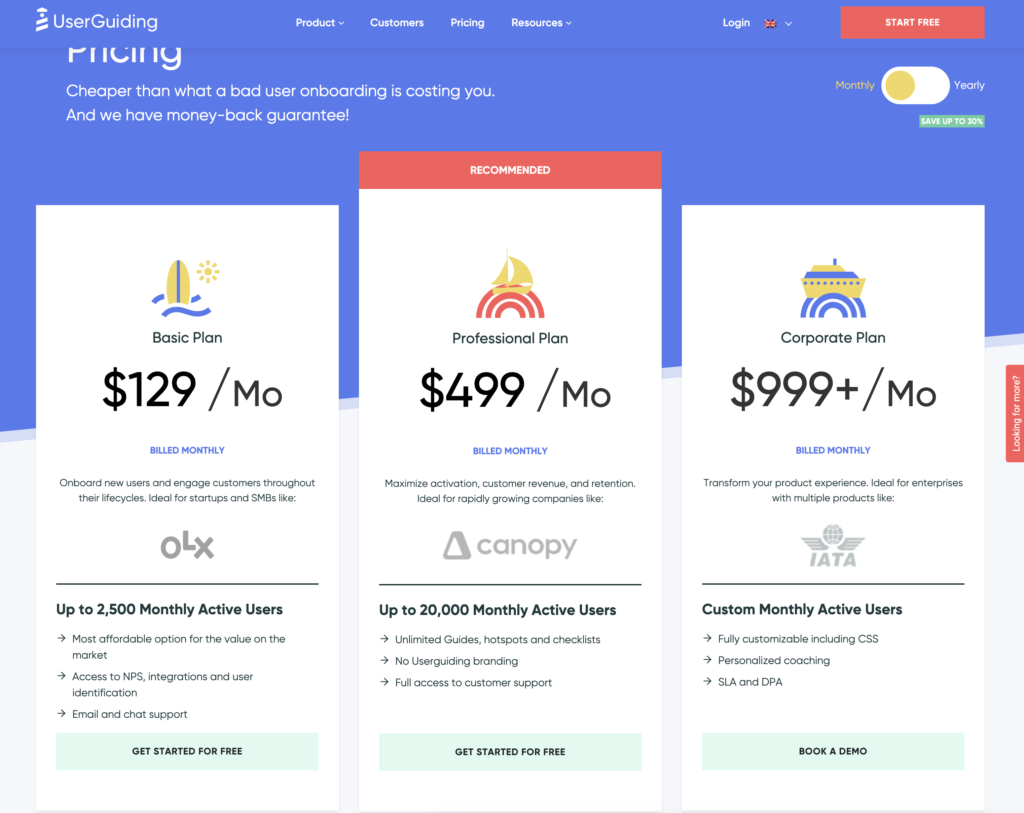
- Basic: Costing $129/month, the Basic plan is targeted towards startups and SMBs. The Basic plan is quite limited as it caps your account at one active survey, two active checklists, and no more than 2,500 MAUs. Features include:
- Access to user identification features.
- Integrations with Google Analytics, HubSpot, Intercom, and more.
- Email and chat support.
- Customizable theme (only one).
- Professional: The Professional plan costs almost 4x as much as the Basic tier at $499/month. That said, it significantly increases capacity to 20,000 MAUs and improves the quality of customer support you’ll receive. Features include:
- Removal of UserGuiding branding.
- Language localization.
- Full customer support access.
- Five team member seats.
- Five customizable themes.
- Unlimited guides and checklists.
- Corporate: Subscriptions on the Corporate plan start at $999/month. Of course, this higher price does come with its fair share of enterprise perks. Features include:
- Service Level Agreement (SLA) + Data Processing Agreement (DPA).
- Up to 10 active surveys.
- Custom MAU capacity based on your needs.
- Unlimited team member seats.
- Unlimited customizable themes.
All monthly plans are marked down by 30% when customers choose to bill annually.
Pricing of Userlane
Userlane’s pricing plan is structured in a customizable pattern. This means you need to get a custom quote to know the plan that fits your brand’s purpose based on the level of your SaaS and the number of acquired customers.
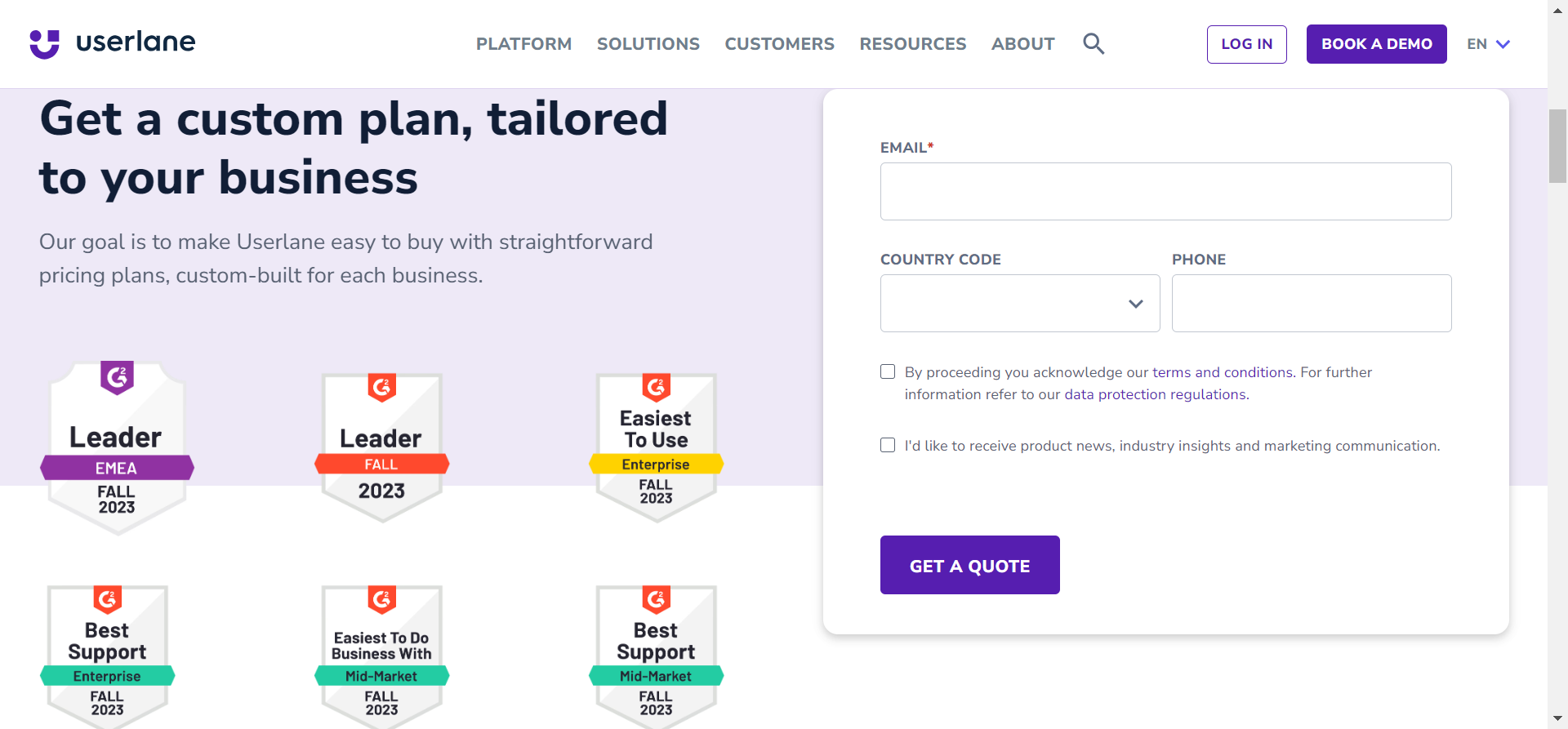
Userpilot – A better alternative for building interactive user guides
Userpilot is a product growth platform that drives user activation, feature adoption, and expansion revenue. It also helps product teams collect user feedback, streamline onboarding, and gather actionable insights from analytics.
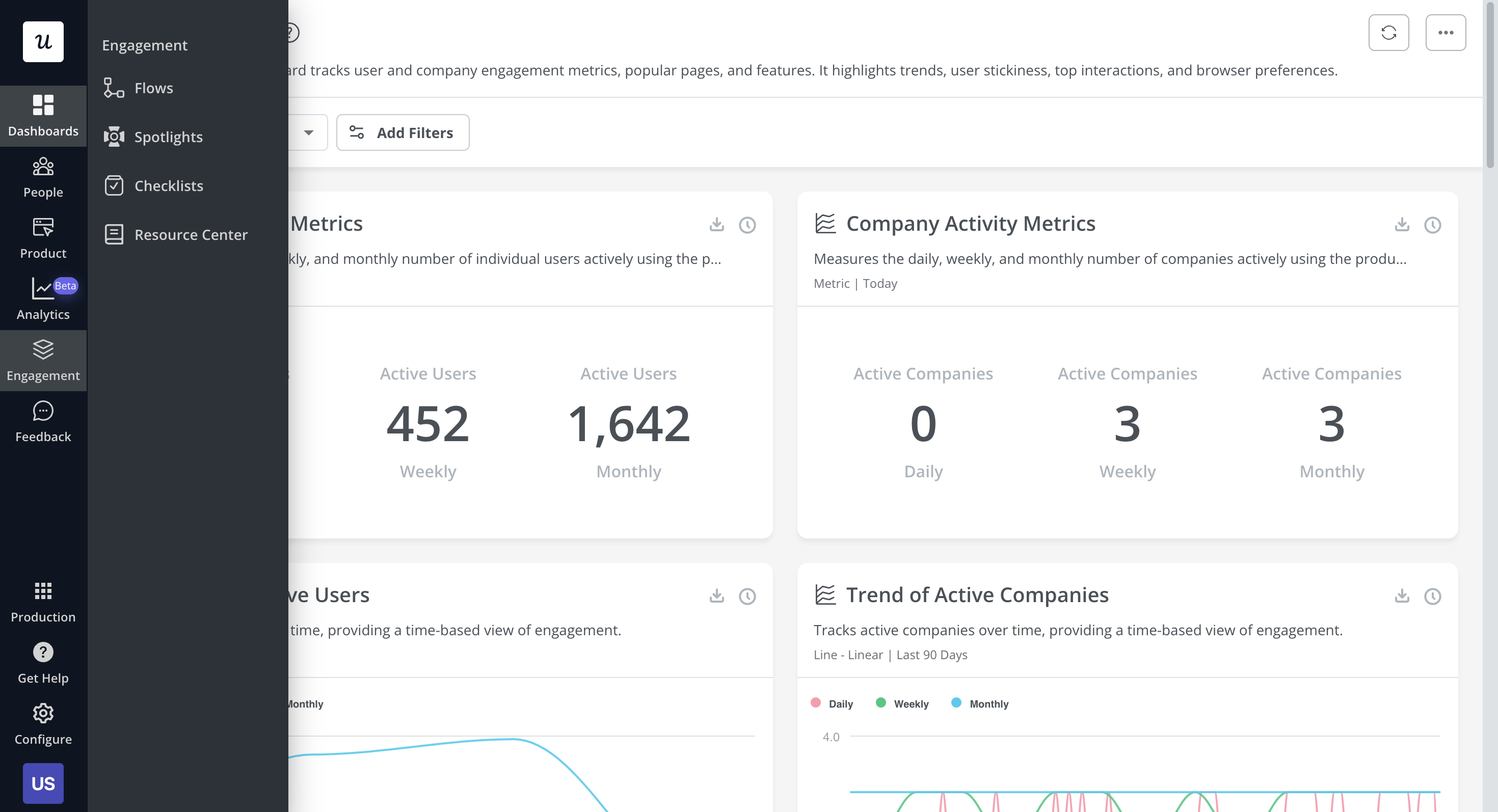
With Userpilot, you’ll be able to track both product usage and user behavior to get a holistic view of how customers use your product — which will guide future development, improve the user experience, and inform your growth efforts.
No-code product tours in Userpilot
Product tours are an effective way to show new users what a product can do and reduce the time-to-value (TTV) for them. Userpilot lets you build advanced product tours, set contextual triggers, and target specific audiences, all without writing a single line of code.
Here are the Userpilot features that you can use to build a product tour for your users:
- Flow builder: Userpilot’s no-code flow builder has a variety of UI patterns to choose from, such as modals, slideouts, tooltips, and driven actions. All UI patterns are available for use regardless of which Userpilot plan you’re on. All you need to do is install the Chrome extension.
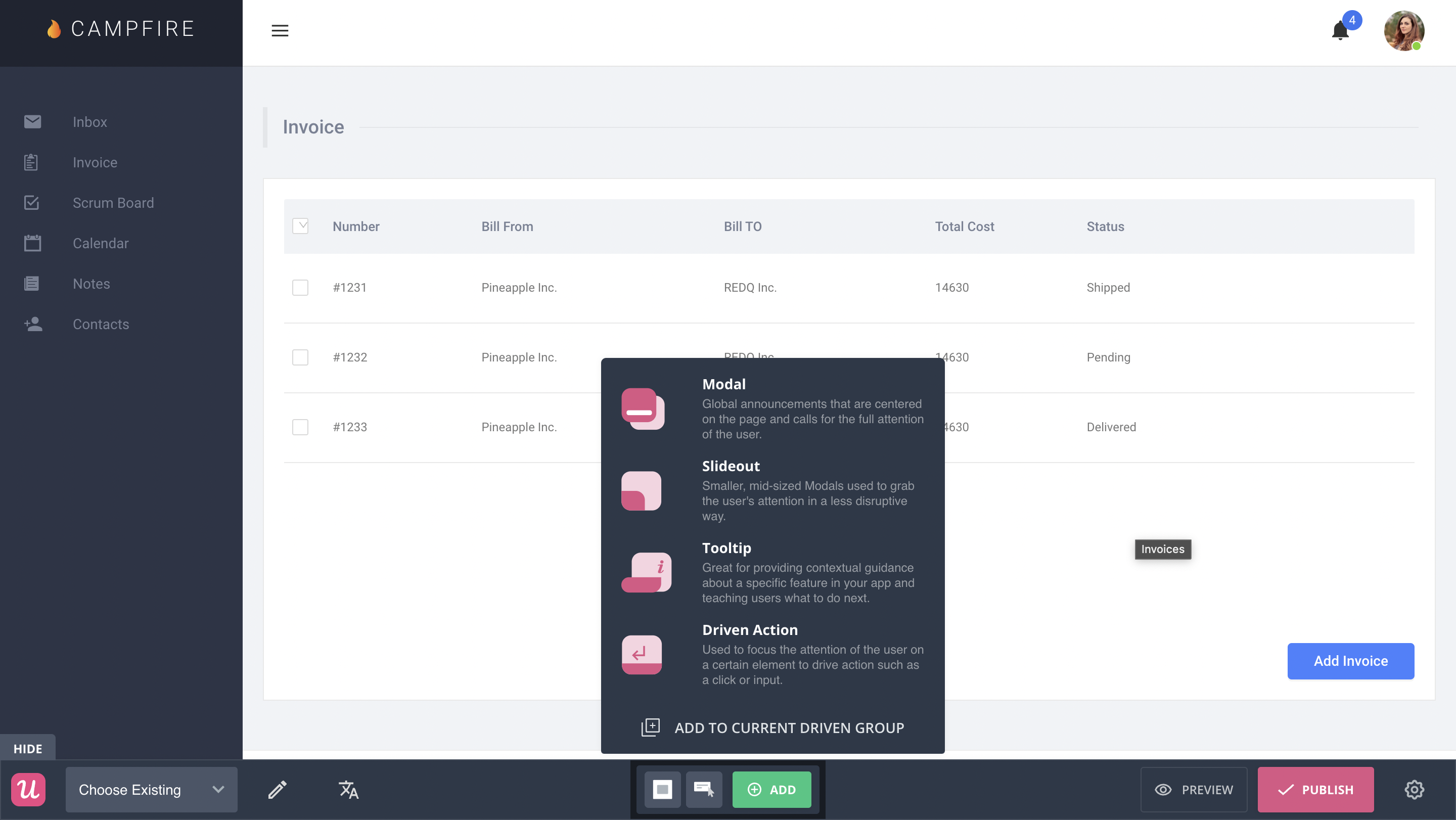
- Contextual triggers: Userpilot lets you set triggers for your flows to ensure that they appear at the most contextual moments. Flows could be triggered when users land on a specific page or when a tracked event occurs. There are also manual triggering options that you can tinker with.

- Audience targeting: Userpilot’s audience targeting setting lets you set the conditions needed for a flow to show up for a specific user. You can use these settings to create flows that target a specific segment or exclude certain users from seeing a flow if certain conditions are met.
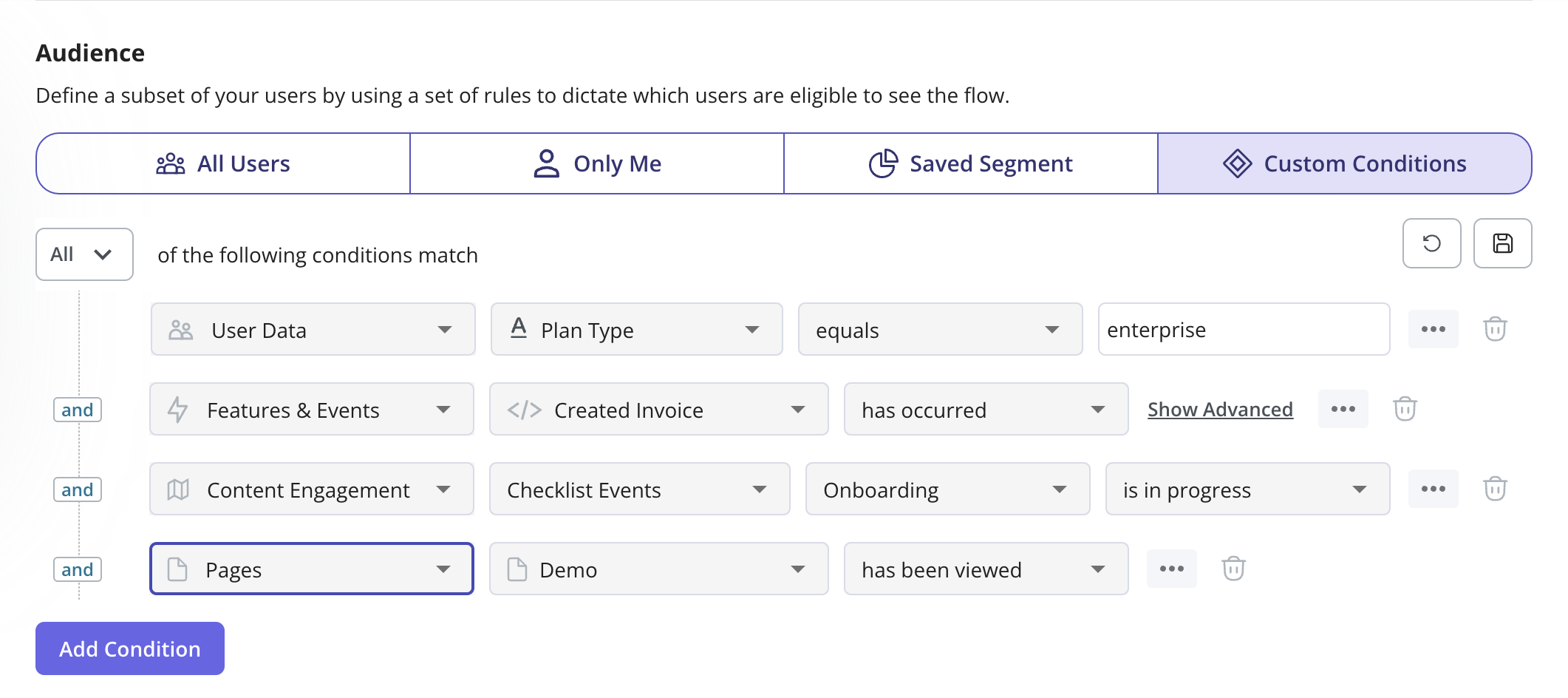
In-app messaging in Userpilot
In-app messaging enables communication within your product to onboard new users or drive feature adoption among existing customers.
Here are a few ways you can send in-app messages using Userpilot:
- Modals: Userpilot lets you use modals to send unmissable in-app messages to your users. Simply choose from one of the six templates or create a new modal from scratch. You’ll be able to use text, emojis, images, and videos to help your modals get the message across to users.
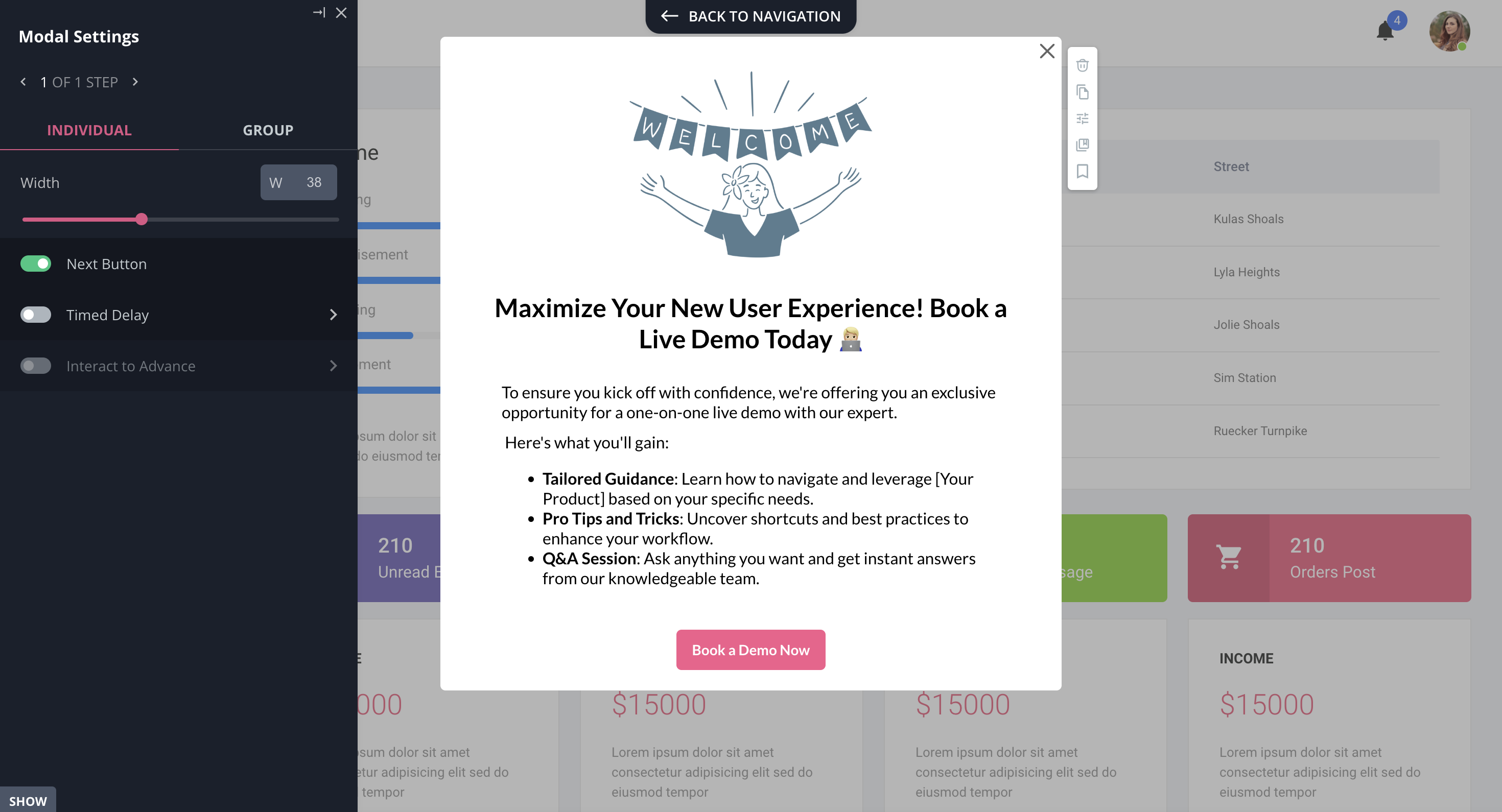
- Banners: Userpilot banners can be used to send in-app messages that are urgent but don’t need to take up the entire screen. You can also add blocks with text, emojis, images, videos, forms, custom JavaScript functions, and more to style banners to your liking.
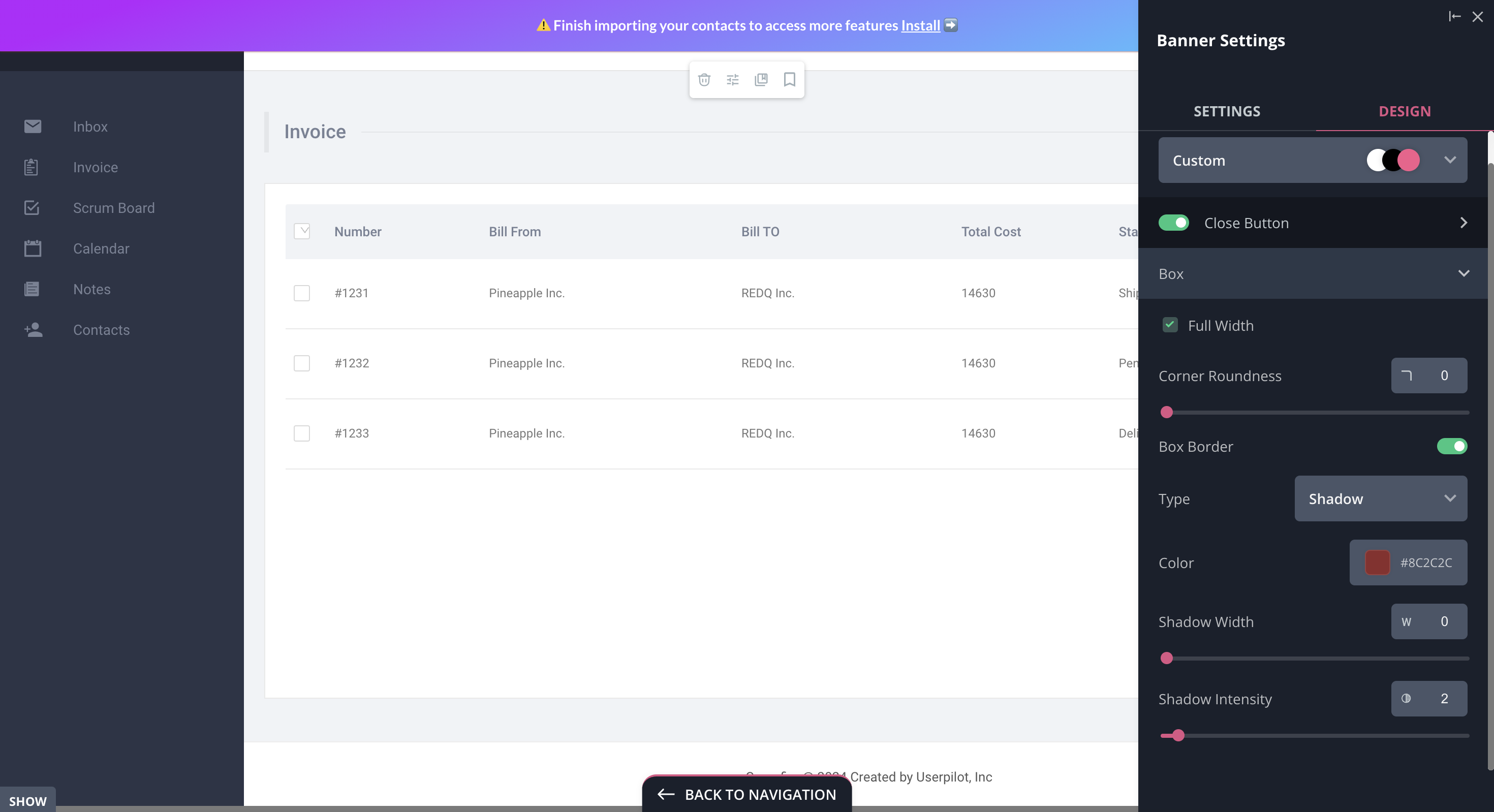
- Tooltips: They are the least intrusive form of in-app messaging as they only show up when users hover over an element or click on an info icon. You’ll be able to adjust the height, shape, color, and placement of tooltips to make them native-like.
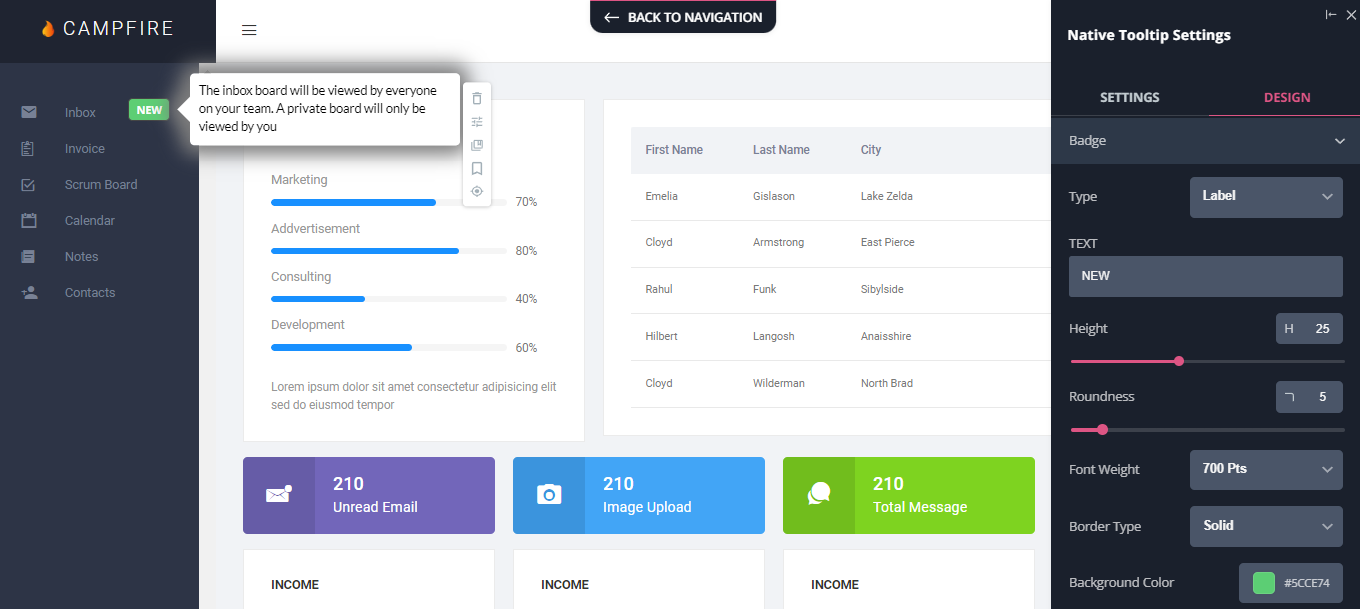
Pricing of Userpilot
Userpilot’s transparent pricing ranges from $249/month on the entry-level end to an Enterprise tier for larger companies.
Furthermore, Userpilot’s entry-level plan includes access to all UI patterns and should include everything that most mid-market SaaS businesses need to get started.
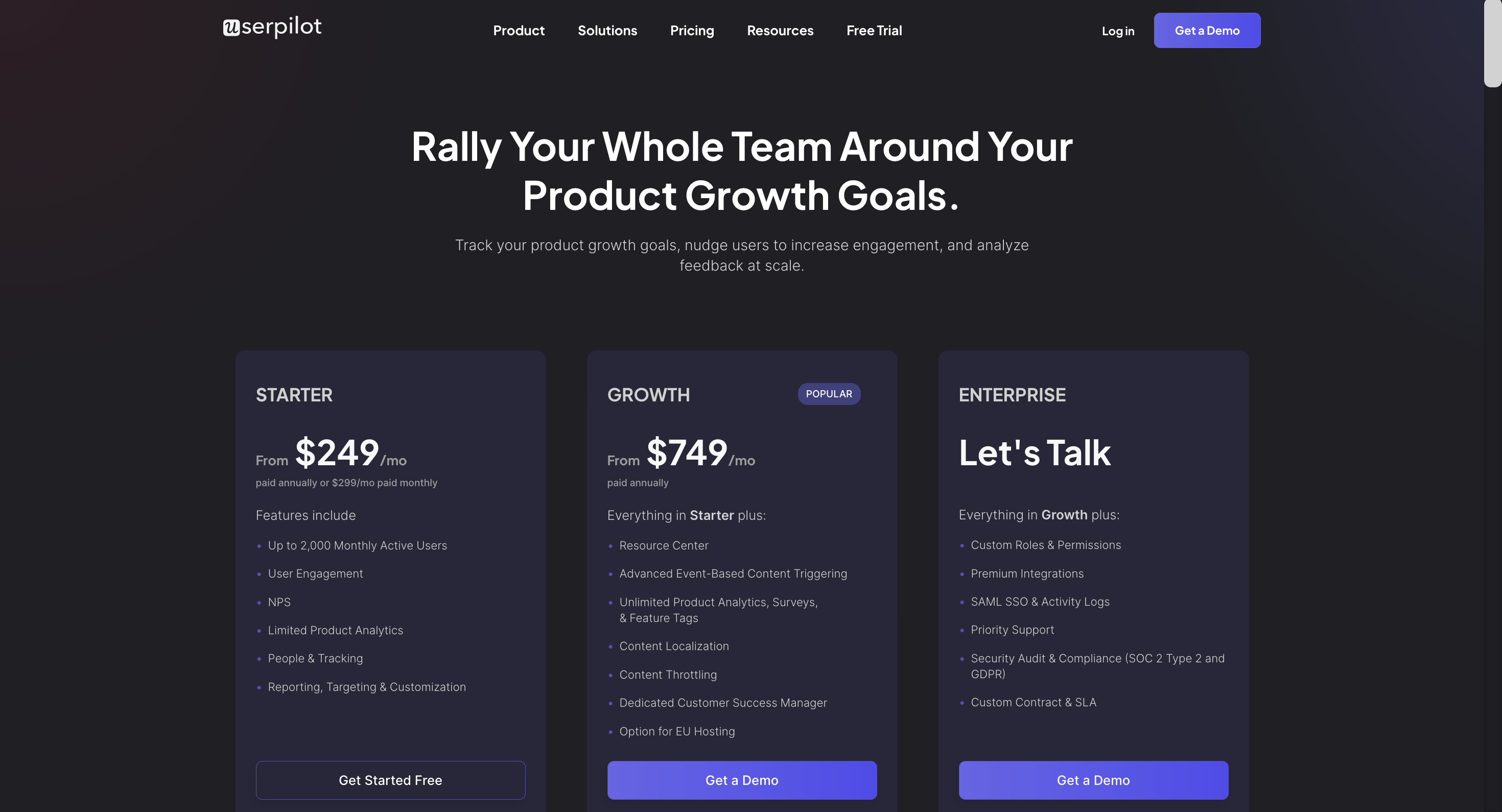
Userpilot has three paid plans to choose from:
- Starter: The entry-level Starter plan starts at $249/month and includes features like segmentation, product analytics, reporting, user engagement, NPS feedback, and customization.
- Growth: The Growth plan starts at $749/month and includes features like resource centers, advanced event-based triggers, unlimited feature tagging, AI-powered content localization, EU hosting options, and a dedicated customer success manager.
- Enterprise: The Enterprise plan uses custom pricing and includes all the features from Starter + Growth plus custom roles/permissions, access to premium integrations, priority support, custom contract, SLA, SAML SSO, activity logs, security audit, and compliance (SOC 2/GDPR).
What do users say about Userpilot?
Most users laud Userpilot for its versatile feature set, ease of use, and responsive support team:
I recently had the pleasure of using Userpilot, and I must say it exceeded all my expectations. As a product manager, I’m always on the lookout for tools that can enhance user onboarding and improve overall user experience. Userpilot not only delivered on these fronts but also went above and beyond with its impressive new features, unparalleled ease of use, and truly exceptional customer support.
What truly sets Userpilot apart is its outstanding customer support. Throughout my journey with Userpilot, the support team has been responsive, knowledgeable, and genuinely dedicated to helping me succeed. Whenever I had a question or encountered an issue, their support team was always there to assist promptly, going above and beyond to ensure my concerns were addressed effectively.
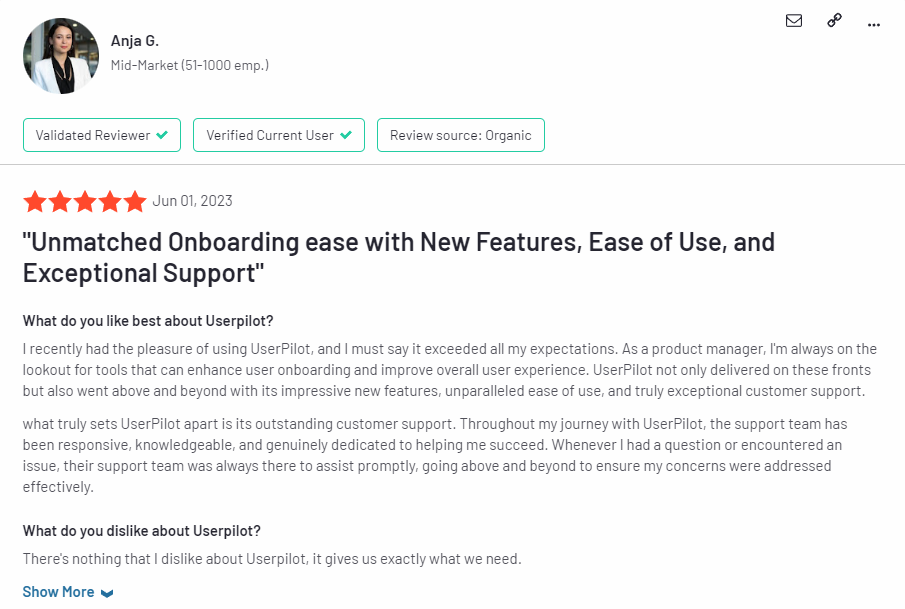
Source: G2.
Of course, other users are also kind enough to share constructive criticism regarding specific features like event tracking filters:
“The filtration while analyzing specific events is a little confusing. Understanding of custom properties and data management configuration could have been more organised.”
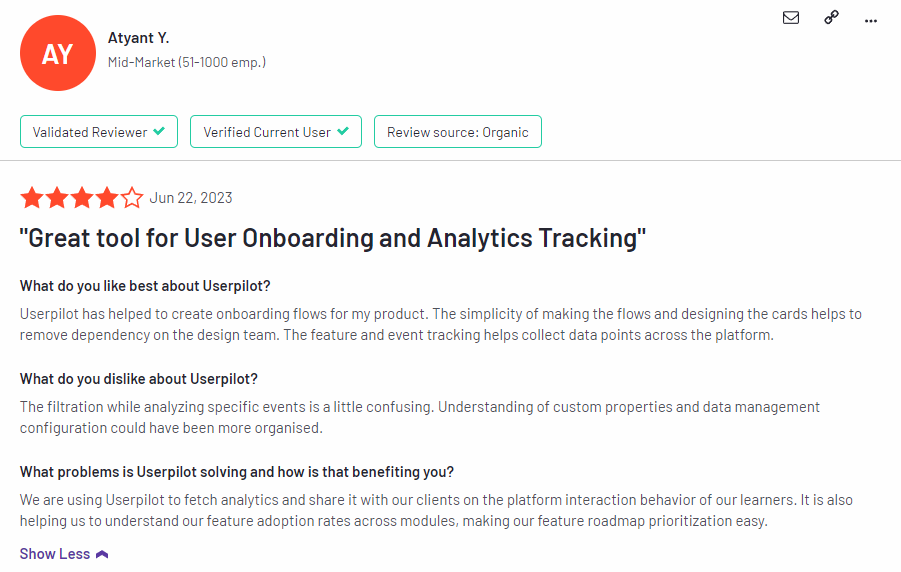
Source: G2.
Conclusion
This is the end of our thorough comparison between UserGuiding and Userlane. You should be able to make a confident decision by now. If you’re looking for a solid tool for building interactive user guides that promises great value for money, give Userpilot a go. Book a demo today.

